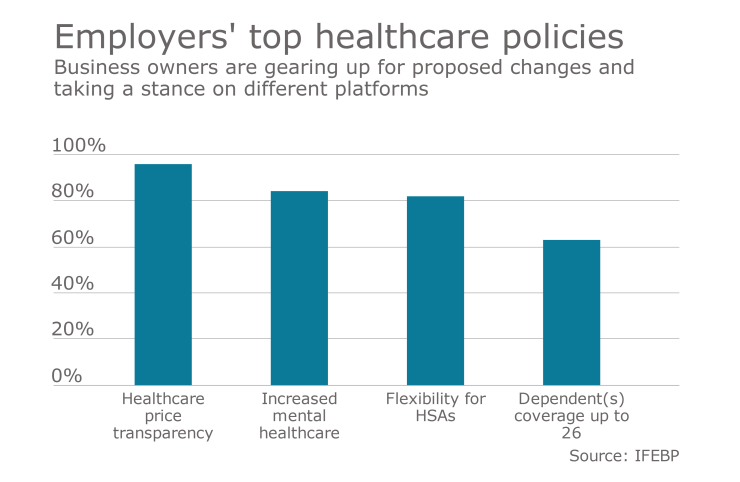The presidential debates are finally over and elections are just a couple of weeks away. Will Hillary Clinton win the peoples’ vote and continue the reign of the Democratic Party for another four years, or will Donald Trump break the liberal streak and usher in new conservative policies into the Oval Office?
From healthcare transparency to paid family leave, the International Foundation of Employee Benefit Plans’ “2016 Election: Employee Benefit Issues” survey report examines campaign issues greatly impacting U.S. workplaces.

“Several important employee benefit issues have emerged as key issues during this year’s election,” says Julie Stich, CEBS, associate vice president of content at IFEBP. “Our survey results show employers support a varied mix of benefit issues being debated.”
Of the issues surrounding healthcare, employers showed their support for:
- More healthcare provider price transparency at 96%.
- Tax-favored status employer-provided health coverage for employers at 87%.
- Small business health plans, or association health plans, that allow small businesses and other groups to join together to offer benefits to their workers and members, which polled at 85%.
- Increased access to mental healthcare at 84%.
- Tax-favored status of employer-provided health coverage for workers at 82%.
Joe Ellis, senior vice president at CBIZ Benefits & Insurance Services, notes the following points as it pertains to the survey and his own observations about benefits issues important to employers with the impending election on the horizon.
"If an employee is going to see a provider, surgeon, etc., they would like to know how much it's going to cost," Ellis says. "That is a very difficult thing to find out because the price depends on who you are and the insurance coverage you have.
Ellis added that medical will usually reimburse at the lowest level and private insurance carriers will reimburse the provider at all different prices because it's what they negotiate individually with that provider.
"Provider A will reimburse at one level [and] insurance company B will reimburse the provider at a different level," Ellis says. "The trouble is that people are demanding price transparency, yet it's virtually impossible to get price transparency for any particular service."
Other benefit-related topics that employers support are:
- Tax-favored status of employer-provided retirement savings for workers at 91%.
Glassdoor’s annual list identifies companies that received high marks for pay and other perks.
- Tax-favored status of employer-provided retirement savings for employers at 88%.
- Tax exclusion for child-care expenses at 75%.
- Tax credits for businesses that hire apprentices at 64%.
- Consolidation of different types of retirement savings vehicles at 60%.
- Living wage or increased minimum wage at 59%.
- Mandated paid family leave at 54%.
“The world of benefits is constantly changing [and] regardless of the election’s outcome, employee benefits will evolve,” Stich says. “To protect the financial future and health of their employees, employers will need to understand and accommodate changes to benefits.”
Ellis says that tax-favored status is the second most important issue to employers because, when employers pay for an employee's healthcare, they don't get the amount of money included in their income.
"Employers want to retain the tax-favored status and they are worried that the federal government is going to take this away," Ellis says. "Since both presidential candidates seem to favor the removal of the Cadillac Tax from the ACA, I think the tax-favored status will always remain a key issue to employers, but I don't see it as being a major issue that is going to be affected by this election."
The survey responses consisted of 486 HR and benefit professionals representing all sectors: public employers, corporate or single employers and multiemployer plans. The organizations represent a wide base of U.S. employers from nearly 20 different industries and range in size from fewer than 50 to more than 10,000 employees.






